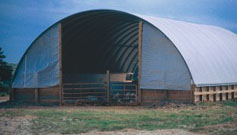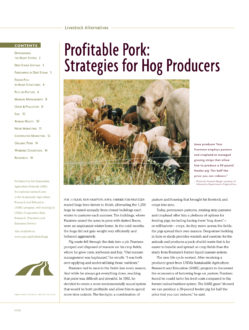
Tent-like shelters that house hogs for a fraction of the cost of a typical confinement house, hoop structures are gaining in popularity as producers realize the benefits of this simple structure that resembles a giant, opaque greenhouse. Originally developed in Canada, 'hoops' usually hold up to 250 hogs on an earthen floor that is heaped with a generous amount of bedding. The structures are topped with 15-feet-high steel arches covered with fabric tarps.
Iowa State University researchers found that initial investment was about one-third cheaper for hoop barns than confinement barns. Confinement operations cost a producer $180 per pig space versus just $55 for a space in a hoop structure. Initial hoop barn construction costs vary from $9,000 to $16,200 to hold 200 head compared to $150,000 to $200,000 for confinement structures that hold 1,000 head.
'Hoops are attractive to a lot of people who don't have a lot of equity to invest,' said Mike Brumm, an extension swine specialist at the University of Nebraska. 'They can pay the day-to-day costs, but don't have to come up with the big money up front.' Hoop structures are 'favorable to beginning farmers who don't have the equity.'
Most hoop structures are used for finishing feeder pigs. Since 1996, close to 3,000 hoop structures have been built in Iowa, where much of the research into alternative swine housing systems is taking place. At Iowa State University, a team of researchers comparing finishing pigs in hoops versus confinement systems found that 'hoop pigs' grew slower in winter and were less efficient than the confinement pigs. In summer, however, the opposite was true.
Yet, weight gain must be compared to costs of production. Overall pig production costs in hoops have been reduced by approximately $4 per hog, according to the nonprofit information clearinghouse, Appropriate Technology Transfer for Rural Areas (ATTRA).
Deep bedding really works as a source of heat. In the winter, researchers have recorded bedding temperatures in hoops to be at least 80º F.
Another big difference between hoop barns and standard hog confinement houses is air flow. While hoop barns are naturally ventilated, confinement systems have forced air systems that rely on electrical power. If a farmer experiences a blackout, the fans cut out and the pigs may die from toxic gas buildup. Most confinement systems therefore include backup generators, which are an added expense and worry for producers. By contrast, Canadian researchers have found that 94 percent of hogs raised in hoop barns exhibited normal lung function, compared with 70 percent of the hogs reared in confinement.
Pigs raised in hoops may develop internal parasites, so aggressive worming is recommended. Otherwise, pigs in hoops are reportedly quite healthy, with foot and leg problems greatly reduced. (See 'Animal Health' in Part II.) Hoop structures require labor to unload bedding, haul solid manure and check pigs.
When evaluating hoop houses:
- Remember that a supply of good-quality bedding is a major consideration.
- Expect higher feeding costs. During the colder months, pigs in hoop structures may need about 10 percent more feed than their confinement counterparts to recover the energy spent keeping warm.
- Make sure you have the equipment necessary for manure loading and handling.
- Develop an internal parasite control program.
